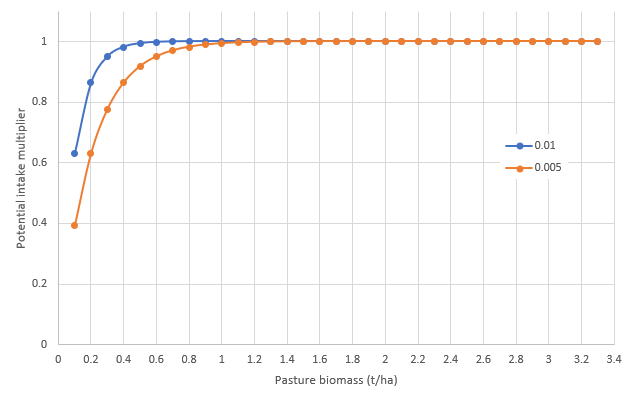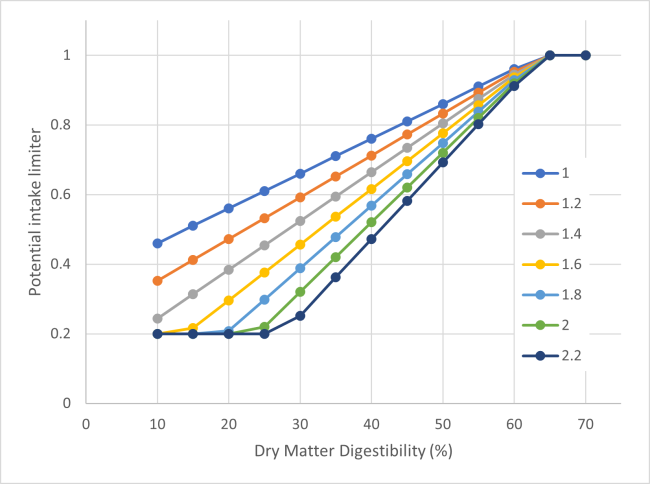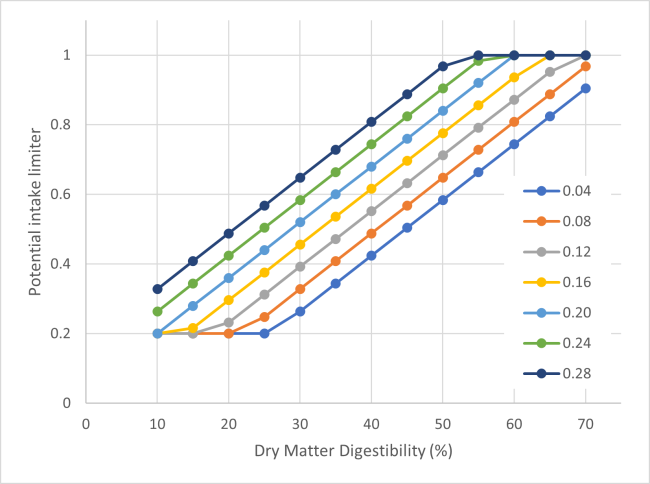 Graze ruminants
Graze ruminants
CLEM.Activities.RuminantActivityGraze
This activity undertakes grazing on pastures.
This section relates to RuminantActivityGrazeAll, RuminantActivityGrazePasture and RuminantActivityGrazePastureBreed activities
The Ruminant graze activities are used to request fodder from grazed pastures (Graze food store type) for each individual in the ruminant herd. This activity provides a grazing arbitration such that multiple breeds competing for a pasture do not get “first come first served” pasture allocation, but rather they have their requirements limited by the total demand for pasture based on a proportional allocation by breed demand.
The composition of the diet made up by fresh green pasture is defined for each individual/herd. As individuals can be moved around during a simulation, the logical place to define the relationship between individuals and each pasture or Graze food store type is with the RuminantActivityGrazePastureBreed activity as it identifies parameters associated with the particular pasture and breed.
The ruminant graze activity relies on the move activity to place individuals in a paddock in order to graze.
There are three types of ruminant grazing activities that can be added to the simulation tree. These depend on the level of detail of your simulation, how much control you wish to have and what level of arbitration you need. They can be thought of as having different levels of background processing provided for you. The simplest approach is to provide a RuminantActivityGrazeAll activity. This will create a range of grazing activities for each combination of pasture and breed and ensure all animals on pasture graze in each time step. The RuminantActivityGrazePasture allows you to specify a pasture for grazing and the simulation model will create the required breed grazing requirements for this pasture. This is sufficient if you only have one pasture in your simulation. The final grazing activity is RuminantActivityGrazePastureBreed and this requires that you specify both the pasture and breed for grazing. You will need to create one of these activities for each pasture and breed combination you wish to simulate. You must also be aware that when moving animals around the property a grazing activity must be supplied for each future outcome of the placement of individuals. For grazing arbitration to be performed all grazing by breed activities must be in a single branch of the simulation tree under a Graze pasture activity.
We highly recommend you use a single instance of the RuminantActivityGrazeAll activity to manage all your grazing requirements. You may place this in different places in the activity tree to determine the grazing priority. For example you may wish to undertake all grazing before feeding the remaining intake required from animal food stores or working out if supplementation is required.
Grazing can occur on common land. See Common land food store type for more details.
The following parameters are used to define this activity
This specifies the number of hours grazed. It is based upon an 8 hour grazing day. You may reduce grazing time if additional feed options are provided.
>0<=8
Required for RuminantActivityGrazePasture and RuminantActivityGrazePastureBreed
This represents the pasture to graze. This entry is a drop down list of available Graze food store type resources of the Graze food store available for this simulation
Required for RuminantActivityGrazePastureBreed
This represents the breed to graze. This entry is a drop down list of available Ruminant type resources of the Ruminant herd available for this simulation
This parameter will determine what action is taken if there are insufficient resources to perform this activity.
You can report an error and stop the simulation, skip this activity or use the resources available. See What to do when resources are limiting
The following components are required to use this activity
Individuals must be moved to a pasture in order to graze. See Move ruminants
A pasture must be set up and managed before grazing can occur
The following components will add additional functionality to this activity
Adding a Labour requirement below this activity will mean that labour is calculated and required to undertake the task.
This activity will occur in every time-step unless timers are used to restrict this activity (see Using timers).
This section needs to be updated to reflect the range of changes in the Major upgrade 2025.
The following section provides details about the process of grazing pasture. This activity will both determine the composition (green to cured) of pasture available and the subsequent amount that can be eaten by each individual in the herd, based on their calculated potential intake multiplied by four limiters to reduce this potential intake (and therefore pasture consumed) of each individual. These relate to the amount of pasture available, the quality of the pasture, the time grazed, and any competition between different breeds grazing the same paddock. All parameters relating to the breed will be found in the Diet category of the Ruminant type.
Potential intake is reduced based on the ability of individuals to locate and consume pasture in the grazing time. This relates to additional time and effort required to search and consume pasture when biomass is low. The IntakeCoefficientBiomass parameter is found in the diet category of Ruminant type resource is used in the following equation along with pasture biomass (in kilograms).
PotentialIntakePastureBiomassModifier = (1 - Math.Exp(-IntakeCoefficientBiomass * TonnesPerHectareStartOfTimeStep * 1000))
The IntakeCoefficientBiomass parameter determines the extent and rate of potential intake reduction as pasture biomass drops to become limiting. The following graph shows the intake reduction based on values set at 0.01 (blue) and 0.005 (orange) for a range of pasture biomasses (tonnes per hectare) as the start of the time-step.

Potential intake is reduced based on pasture quality using the following relationship
PotentialIntakePastureQualityLimiter = 1 - IntakeQualityCoefficient * (0.8 - IntakeTropicalQualityCoefficient - DMDpasture / 100)
where IntakeQualityCoefficient and IntakeTropicalQualityCoefficient are parameters of the pasture (Graze food store type)
The IntakeQualityCoefficient is a fixed reduction in potential intake relating to the quality of the pasture. The graph below shows the reduction in potential intake as the dry matter digestibility of the pasture (DMD%) changes with a IntakeTropicalQualityCoefficient of 0.16.

The IntakeTropicalQualityCoefficient determines an additional reduction in potential intake relating to the increased effort to digest tropical C4 pastures with high levels of silica. The graph below shows the reduction in potential intake as the dry matter digestibility of the pasture (DMD%) changes with a IntakeQualityCoefficient of 1.6.

The model currently assumes a maximum of eight hours grazing per day. This limiter is based on the proportional reduction from eight hours based on the user specified Hours grazed.
GrazingTimeLimiter = HoursGrazed / 8
The grazing intake is calculated for each individual based on its potential intake multiplied by each of the limiters and accounting for any feed provided prior to the grazing activity. Therefore each limiter is cumulative .
Intakegrazing = Intakepotential * PotentialIntakePastureBiomassLimiter * PotentialIntakePastureQualityLimiter * PotentialIntakeGrazingTimeLimiter
Once each individual's possible pasture intake (adjusted potential intake minus anything already fed), the animals can be assigned pasture from different pools to satisfy the demand. This intake will next be defined by the proportion of green material permitted in the individuals (breed) diet.
As pasture grows (green growth), it is added to the model as a new pasture pool (see Graze food store type). This pool can subsequently degrade in quality (N% and DMD%) and lose biomass through detachment over time based on settings in the Graze food type. While high quality and desired by ruminants, the ability to consume green pasture declines as its proportion of total pasture declines.
Limits can be placed on how much fresh, green material breeds can consume when grazing using the following equation:
green limit (%) = (GreenDietmax*100) * (1 - Math.Exp(-GreenDietcoefficient * ((ProportionGreen*100) - (GreenDietZero*100))))
where GreenDietMax, GreenDietCoefficient and GreenDietZero are parameters of Ruminant type and proportion green is the current proportion of the pasture that is green.
The calculation of the proportion of the pasture that is considered green age currently assumes the seasonal timing of northern Australia with pasture less than 3 months old in Jan to March considered green, otherwise less than 2 months old, given the timing of rainfall. This may need to be updated with additional functionality in order to work in other locations.
This green limit is then applied to any pool considered green and the product of the monthly intake and the limiter (as a proportion) will determine the maximum proportion of the diet that can be taken from each of these green pools.
The grazing competition limiter is a calculation of the proportion of available pasture provided to the breed after accounting for the entire herd demand, when there is insufficient pasture available to meet the needs of all individuals in the paddock/pasture.
With the previous values calculated the desired and required amount eaten can be calculated for the herd where desired is the animals physiological requirement minus the reduction from biomass and quality limiters, while the required amount in the time step also includes any grazing time limiter amount, therefore reflecting the management-based reduction in diet. After allocation of pasture, the total eaten is then reduced by the Grazing competition limiter to account for competition from other breeds when pasture is in shortfall to the herd required amount.
The amount eaten is then taken from the pasture pools based on the green pasture limits for the breed and the quality of pasture consumed (Nitrogen percent and DMD) is tracked for energy budgets.
The Resource shortfalls report will identify where pasture available was below that required and desired by the herd to understand the pasture provided to the herd in relation to demand. These shortfall entries are identified with a Status of BelowRequired and Action of Partial, or a Status of BelowDesired and Action of Success. See Resource shortfalls report for information on setting the reporting cut-off value for this shortfall.
This activity is performed during the Get Resources Required event of the setup and time-step events. This is the standard, monthly clock event by which CLEM activities request resources and perform actions based on the resources provided, therefore this activity will compete with most activities in the time-step with their location in the simulation tree determining the order they are processed (this includes activities located on other CLEM and Market components). If this activity relies on another activity having been performed, or other activities rely on this activity in the time-step, ensure it has been performed in the correct order based on it's position in the simulation tree.
The following status values apply to this activity and are shown in Activities performed report:
|
|
blank | The activity was not considered in this time-step |
|
|
no task | This will appear for parent grazing activities. Status entries will only be provided for PastureHerd grazing components |
|
|
not needed | There was no herd or no pasture was consumed |
|
|
partial | Only a portion of the required grazing intake was provided. This is likely due to grazing competition between herds or low pasture levels |
|
|
success | All individuals grazed the required pasture |
|
|
warning | No pasture available |
See also